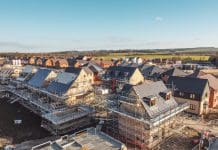Amidst a global call for environmental accountability, the construction industry’s significant carbon footprint is under scrutiny. A study from Judy Too and Obuks Ejohwomu, University of Manchester, exposes a critical gap: buildings are still not designed within sectoral carbon budgets, hindering progress towards net-zero
In an era marked by growing environmental concerns and the urgent need to combat climate change, the construction industry has faced increasing scrutiny due to its substantial carbon footprint.
As a sector responsible for 39% of global carbon emissions and 25% of GHG emissions in the UK, the role of buildings in the journey towards net-zero cannot be overstated.
There is an increasing consciousness about climate change through the implementation of initiatives such as the Royal Institute of British Architects (RIBA) 2030 Climate Challenge and the adoption of the RICS Whole Life Carbon Assessment (WLCA) standard.
Buildings are still not designed within the constraints of sectoral carbon budgets
Our research, aimed at understanding contemporary building practices after climate emergency declarations, revealed that buildings are still not yet designed or delivered within the constraints of sectoral carbon budgets.
The carbon budget represents the maximum permissible emissions that humanity can release from the present until 2050 without surpassing specified temperature increase thresholds, as projected by the Intergovernmental Panel on Climate Change.
Unlike an annual budget, the carbon budget is a cumulative measure of the past, present, and future. In essence, it signifies a transitional phase towards achieving a state of net-zero carbon emissions.
Therefore, once the allocated budget is depleted, subsequent emissions must be held at zero to prevent further global temperature increases.
Taking a top-down approach, a portion of the global carbon budget is allocated to individual countries to formulate national carbon emission reduction pathways. Ideally, these allocations should subsequently cascade down to the sectoral level, further extending to individual projects.
The construction industry has yet to adopt performance limits for the various phases of the lifecycle of a building
However, the UK building sector has yet to adopt predefined performance limits and benchmarks for the various phases of a building’s lifecycle in accordance with the sectoral carbon limits.
Considering the timeline to 2050, our research has spurred the call for immediate policy reforms that require buildings to be delivered in line with project-level carbon budgets. This approach will ensure that the sector makes substantial progress towards achieving net-zero carbon emissions by 2050.
However, amid these obstacles, promising initiatives and strategies exist that, although progressing slowly, hold the potential to revolutionise the sector.
Our research established that this holistic transformation relies on three key pillars (policy and regulations, building sector practices and public engagement/education) that collectively champion a performance-based culture within the sector.
This cultural shift, fostered by the synergy between these three pillars is essential to compel developers to achieve specific environmental performance goals related to energy, water, and waste reduction.
How can developers set out to achieve environmental performance goals?
1. Policies and regulations
Initiatives such as the UK Net Zero Carbon Buildings Standard, Future Homes Standard, and the proposed Part Z amendment are crucial frameworks for guiding the sector towards carbon-conscious decisions.
While these are still in their infancy and have not yet been fully enforced, our research found that forward-thinking investors and clients (early adopters) willing to pay the cost premium to achieve ambitious goals are already driving this change and pushing the demand for low-carbon solutions.
For instance, developers are already building solar-powered homes with improved insulation and intelligent control systems to lessen the demand on the electricity grid during peak usage periods.
Furthermore, a growing recognition of embodied carbon contribution to whole building lifecycle emissions drives the demand for low-carbon materials. However, cost constraints in a post-pandemic world remain a barrier.
Therefore, these initiatives must be backed by robust standards and long-term regulatory frameworks to prevent other developers (laggards) from undercutting quality. This will offer assurance and create an equitable environment, allowing participants within the supply chain to innovate, thereby reducing costs.
2. Building sector practices
The shift towards a low-carbon sector demands a significant change in building design practices and project evaluation.
Our research revealed that, in most cases, short-term financial considerations take precedence over long-term environmental benefits.
While low-carbon options often result in long-term cost savings through reduced energy consumption and operational expenses, the initial investment can be higher. Consequently, developers are hesitant to commit to higher upfront costs due to a lack of complete understanding regarding the potential return on investment (ROI) over the building’s lifespan.
This lack of awareness and the absence of regulatory mandates make it challenging for practitioners to prioritise low-carbon alternatives and integrate sustainable practices effectively.
To accelerate this transition, stakeholders must weigh a project’s carbon impact on par with its financial viability. Merely focusing on the financial bottom line is no longer adequate.
As investors progressively look beyond the financial and economic value of assets to understand their Environmental, Social, and Governance (ESG) credentials, the discourse between stakeholders is expected to evolve from a traditional budget-centric mindset i.e. “What can be achieved within a budget of X?” to a more carbon-conscious approach i.e. “What can be accomplished within a carbon limit of X?” Subsequently, engineers and designers will utilise this threshold to guide their building designs and material choices.
At this point, project success will likely be redefined and evaluated by comparing actual performance against the projected carbon budget at different phases of the project lifecycle. Our research lays the groundwork for standardizing performance measurement throughout the project lifecycle, guiding this transition.
Driving this transformation demands the sector’s adoption of an integrated design process. This approach involves a holistic assessment of building components and systems, emphasising their collective performance and environmental impact.
Taking this holistic view prompts stakeholders to assess the overall sustainability of a project rather than isolated elements or individual components, identifying opportunities for carbon reduction and cost savings that might otherwise be overlooked.
3. Public engagement and education
As public awareness of environmental issues and the urgency of climate action grows, there is an increased demand for zero-carbon building developments from both clients and occupants.
This heightened awareness is a potent force that drives change within the building sector. Clients and occupants increasingly seek sustainable, energy-efficient, and environmentally friendly buildings.
To meet this demand, the sector must adapt and provide solutions that adhere to budget constraints and align with carbon limitations.
Though the transformation might seem gradual, if further leveraged and supported, these initiatives and strategies can expedite the sector’s shift towards achieving net-zero carbon emissions target by 2050.
Incentivising and imposing penalties prompts behavioural changes in building design and evaluation practices, concurrently heightening public awareness. This increased awareness subsequently empowers end-users to advocate for sectoral changes actively.
This cohesive, synchronised effort will pave the way for a performance-based culture, ultimately driving the delivery of buildings within the UK carbon budget.
 Judy Too is a final year PhD Candidate pursuing a joint programme between the University of Manchester and the University of Melbourne under the Global Doctoral Research Network. Her research project, titled ‘Standardising Carbon Neutrality in the Delivery of Complex Projects’, examines the trade-off between cost and environmental impact of various decarbonisation strategies to develop a cost-decarbonisation framework for complex infrastructure projects. She previously worked as an Assurance Associate at PricewaterhouseCoopers Limited.
Judy Too is a final year PhD Candidate pursuing a joint programme between the University of Manchester and the University of Melbourne under the Global Doctoral Research Network. Her research project, titled ‘Standardising Carbon Neutrality in the Delivery of Complex Projects’, examines the trade-off between cost and environmental impact of various decarbonisation strategies to develop a cost-decarbonisation framework for complex infrastructure projects. She previously worked as an Assurance Associate at PricewaterhouseCoopers Limited.
 Obuks Ejohwomu is a Reader in Sustainable Built Environment and Project Management and Head of Admissions for the School of Engineering. He is listed as one of Manchester’s Heritage Heroes for the impact of his research work. Obuks particularly leads a research group focusing on a future sustainable built environment. He has managed grants valued at £503,406. Associate Editor, Journal of Engineering Design and Technology (JEDT) and Lead Guest Editor – Special Issue in Building Performance Gaps and the Decarbonisation Challenge.
Obuks Ejohwomu is a Reader in Sustainable Built Environment and Project Management and Head of Admissions for the School of Engineering. He is listed as one of Manchester’s Heritage Heroes for the impact of his research work. Obuks particularly leads a research group focusing on a future sustainable built environment. He has managed grants valued at £503,406. Associate Editor, Journal of Engineering Design and Technology (JEDT) and Lead Guest Editor – Special Issue in Building Performance Gaps and the Decarbonisation Challenge.














